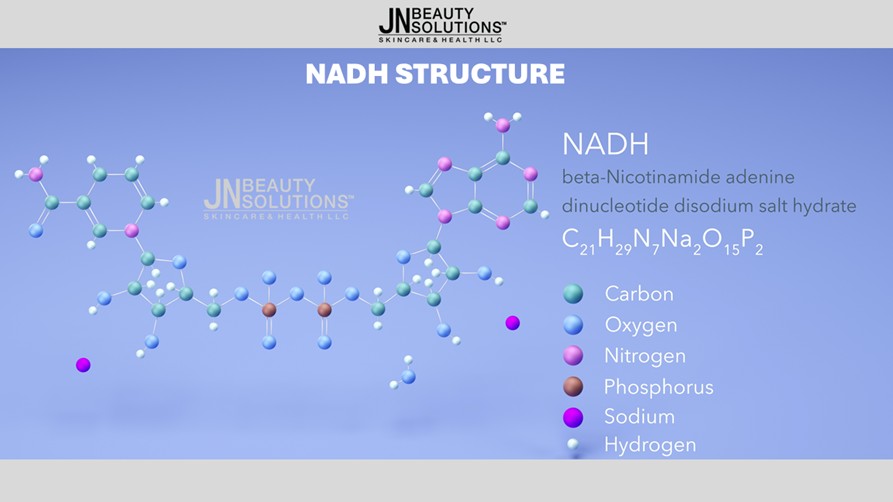OVERVIEW
NADH (Nicotinamide Adenine Dinucleotide – Reduced Form) is a biologically active coenzyme essential for cellular energy production, particularly in high-demand tissues such as the brain, heart, and muscles. As the electron-rich counterpart of NAD⁺, NADH donates electrons during metabolic processes, directly fueling ATP synthesis in the mitochondria.
It plays a vital role in oxidative phosphorylation, neurotransmitter biosynthesis, and antioxidant defense. NADH supplementation has been studied in the context of chronic fatigue, cognitive decline, Parkinson’s disease, and mitochondrial dysfunction, and is increasingly used in anti-aging and integrative medicine protocols.

MECHANISM OF ACTION
NADH is primarily produced during cellular respiration (especially in the Krebs cycle) and donates electrons to Complex I of the electron transport chain, enabling the generation of adenosine triphosphate (ATP)the body’s main energy molecule.
In addition to its role in energy production, NADH also contributes to:
- Antioxidant defense by maintaining redox balance and supporting glutathione recycling
- Neurotransmitter synthesis, including dopamine, norepinephrine, and serotonin
- Brain metabolism and alertness, especially under conditions of fatigue or neurodegeneration
- Mitochondrial biogenesis and cellular repair processes
COMPARISON: NAD⁺ vs. NADH
While both NAD⁺ and NADH are essential for cellular function, they play complementary but distinct roles:
- NAD⁺ primarily serves as an electron acceptor in metabolic reactions, is essential for DNA repair, and activates longevity-related enzymes such as sirtuins and PARPs. It is widely researched for its role in anti-aging, metabolic regulation, and epigenetic health.
- In contrast, NADH functions as the electron donor form, supplying the electrons necessary for ATP generation. NADH directly fuels cellular energy production, making it particularly beneficial in conditions associated with fatigue, cognitive impairment, and poor mitochondrial performance.
- In short, NAD⁺ supports metabolic signaling and cellular resilience, while NADH powers immediate energy needs and neurological function. Both are essential but serve different purposes in the cell’s redox and energy systems.
CLINICAL APPLICATIONS
1. Chronic Fatigue Syndrome (CFS) and Energy Deficiency
NADH has been shown to improve energy levels and reduce fatigue in patients with CFS, fibromyalgia, and exercise intolerance, especially in individuals with mitochondrial dysfunction or low baseline ATP production.
2. Neurological and Cognitive Health
NADH enhances cerebral energy metabolism and dopamine synthesis. Clinical trials have reported improvements in alertness, memory, and cognitive processing, with promising applications in Parkinson’s disease, Alzheimer’s disease, and age-related cognitive decline.
3. Mental Health and Mood Support
By supporting monoamine neurotransmitter biosynthesis, NADH may benefit individuals with depression or low motivation, particularly in cases involving energy metabolism deficits.
4. Cardiovascular and Physical Performance
NADH supports myocardial energy output and may improve endurance, recovery, and physical capacity in both elderly and athletic populations.
SUPPLEMENTATION AND DELIVERY
NADH is available in several delivery formats:
- Sublingual or enteric-coated oral tablets: Common therapeutic doses range from 5–20 mg/day. These forms are used to bypass degradation in the stomach and improve absorption.
- Intravenous NADH (less common): May be used in clinical settings for patients with advanced fatigue, neurodegeneration, or chronic illness.
- Combination formulas: Often paired with nutrients like CoQ10, L-carnitine, or riboflavin in mitochondrial support protocols.
SAFETY AND TOLERABILITY
NADH is well tolerated in both clinical and wellness settings. Side effects are rare and usually mild, and may include:
- Occasional nausea, headache, or stimulation (especially at higher doses or in sensitive individuals)
- Transient restlessness or sleep disturbance if taken too late in the day
- No toxicity has been reported in clinical studies at standard doses.
PRECAUTIONS AND CONTRAINDICATIONS
- Caution is advised in individuals with bipolar disorder, as NADH may enhance dopamine activity.
- Avoid late-day dosing to prevent overstimulation or insomnia.
- NADH should be used under professional supervision in patients with advanced neurological disease or cardiovascular instability.
CONCLUSION
NADH is a powerful mitochondrial coenzyme that supports energy production, mental performance, and neurological health. As the reduced, active form of NAD⁺, it plays a unique and irreplaceable role in the body’s bioenergetic and redox systems.
By replenishing NADH, individuals may experience enhanced mental clarity, physical energy, and cellular efficiency, making it a key component in personalized strategies for anti-fatigue, brain health, and functional longevity.
For more products information, please contact
JN BEAUTY SOLUTIONS™

